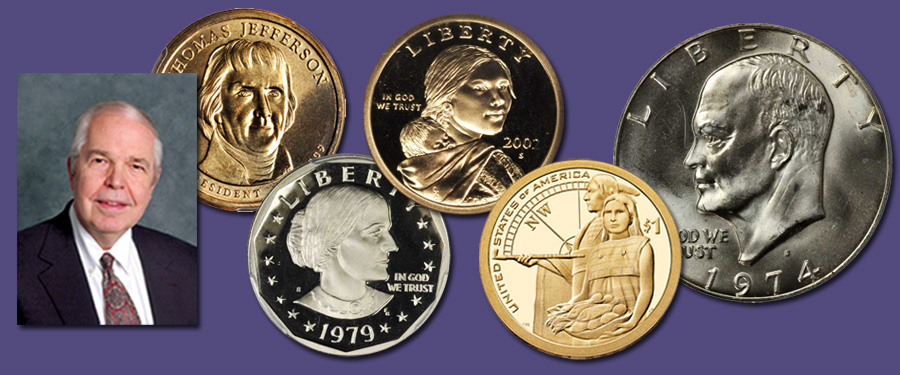
In recent months I have been working on and off on a manuscript for Whitman covering modern dollar coins from 1971 to date. In essence these comprise Eisenhower dollars (1971-1978), Susan B. Anthony dollars (1979-1981 and then a stray issue in 1999), Sacagawea dollars (2000 onward), blending into the current Native American dollars and Presidential dollars (2007-date).
A basic set of date and mintmark varieties, circulation strikes and Proofs, is very affordable. While some issues are scarcer than others, there are no great rarities. Among Eisenhower dollars the early circulation issues are elusive in Gem Mint State, but other dollar coins are available easily enough. The so-called golden dollars from 2000 to date are a good way to start. Mounted in an album, these can be interesting to contemplate and study. There is a zinger, however: starting with the Presidential dollars in 2007 and continuing with the native American dollars (with the Sacagawea obverse) in 2009, the Mint did something that is curious and defies numismatic logic. The date and mintmark of each coin is on the edge, not visible on the face or reverse, and completely hidden when a coin is in an album. Of course, if we know that the John Adams Presidential dollar was issued only in 2007 it can be put in the proper place, but still, seeing a date and mintmark is numismatic tradition. The idea was, I suppose, that fewer dies would need to be made.
The Native American dollars, which I find to be particularly interesting, have an undated Sacagawea obverse, meaning that dies can be kept on hand from one year to the next. The reverse is distinctive each year.
The Presidential dollars from 2007 onward have endured quite a bit of criticism in the numismatic press. First of all the portraits, while different for each person and adapted from earlier medals, are not particularly interesting in the view of many observers. It would have been nicer, some say, to have shown a portrait on one side and, following what was done with Lincoln cent reverses in 2009, have the reverse illustrate something in a particular president’s administration. Beyond that, some presidents are distinguished and honored today and others are not. Diverse backgrounds keep the series interesting, of course, if you tend to go beyond the coins themselves and look up the biographies of those depicted.
Very unfortunately, 2016 is scheduled to be the end of the golden dollar. The Presidential series will terminate with just two portraits, as the other presidents past and present are still living, and they cannot be honored until two years after their passing. The Native American dollars will also expire, although it would seem there would be no end of interesting subjects to continue production for many years to come.
There have been quite a few instances in American history in which there have been no dollar coins produced for given dates. 1805 through 1835 is the first stretch, followed by 1838, then 1874 to 1877 (unless you call the trade dollar a silver dollar), then again from 1905 to 1920, further from 1929 through 1933, again from 1936 to 1970 (although an issue of 1964-dated coins was contemplated), and followed by 1982 through 1998. Now it seems that unless Congress takes action, we will have another gap starting with 2017.





